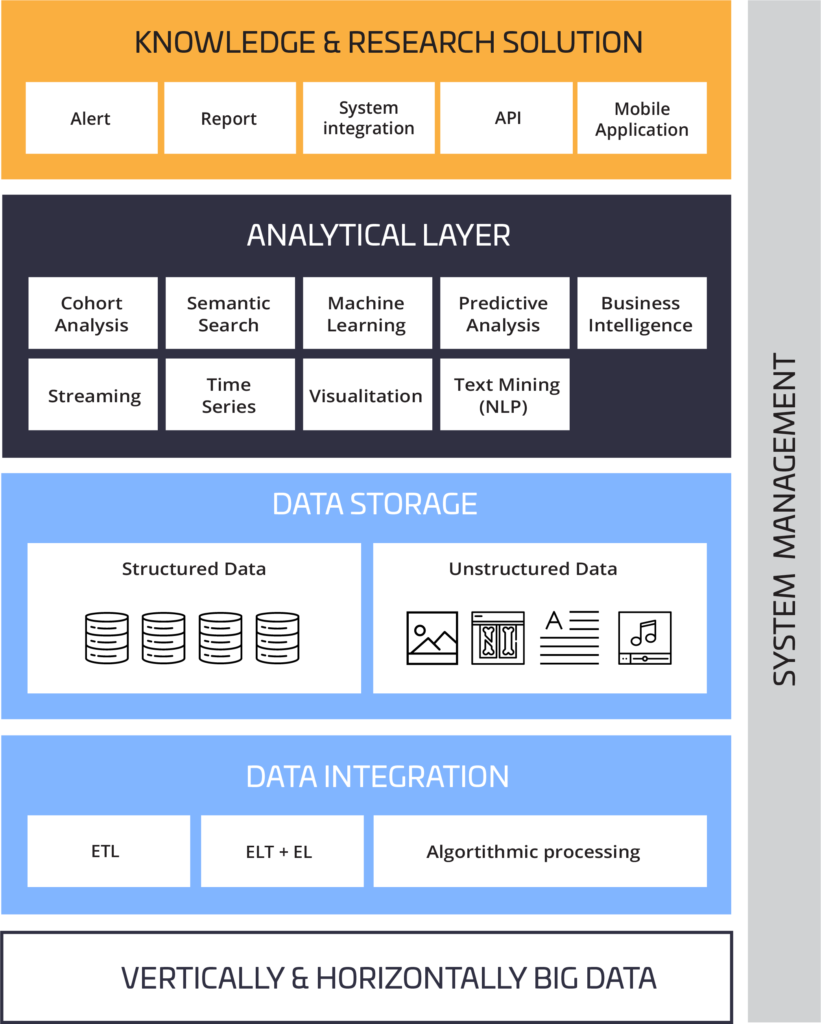Products Smart Data SmartData Platform

Your data are always accessible in any form you need or you might need in the future. The Data Layer gives the right data infrastructure for data injection, data integration, data structure and supports complex accessibility and data encryption procedures. The solution deals with both horizontally (large amounts of data) and vertically (multiple types of data) scaled, structured or unstructured data as well as data from a variety of data sources. This layer enables data virtualization (access data without physical data collection), canalization, and data warehouse elements can be embedded into this layer as well.
The Analytical Layer plays a significant role in extracting the right information with a wide variety of tools and methodologies. With the use of Business Intelligence solutions like Power BI, the data are visually presented in a way that you will be able to discover hidden correlations and tendencies or test and prove your hypotheses. ML-AI solutions can help you find the potential root-cause of your current problem or predict an event, incident or the right time to intervene.
The Knowledge & Research Layer represents real-life solutions, like real-time reports, alerts and can be integrated with already exciting applications. This layer utilizes the results from the Analytical Layer, which we combine into a flow, a procedure or even a feedback directly to the operational system.
The Unified Management Layer secures the system traceability, accessibility and supports common system operation services.

Your data are always accessible in any form you need or you might need in the future. The Data Layer gives the right data infrastructure for data injection, data integration, data structure and supports complex accessibility and data encryption procedures. The solution deals with both horizontally (large amounts of data) and vertically (multiple types of data) scaled, structured or unstructured data as well as data from a variety of data sources. This layer enables data virtualization (access data without physical data collection), canalization, and data warehouse elements can be embedded into this layer as well.
The Analytical Layer plays a significant role in extracting the right information with a wide variety of tools and methodologies. With the use of Business Intelligence solutions like Power BI, the data are visually presented in a way that you will be able to discover hidden correlations and tendencies or test and prove your hypotheses. ML-AI solutions can help you find the potential root-cause of your current problem or predict an event, incident or the right time to intervene.
The Knowledge & Research Layer represents real-life solutions, like real-time report, alerts or applications we developed for your business need. This layer utilizes the results from the Analytical Layer, which we combine into a flow, a procedure or even a feedback directly to the operational system.
The Unified Management Layer secures the system traceability, accessibility and supports common system operation services.
The DLX Data Platform, built on SQL Server, MinIO, SPARK and K8S technology, can be installed in the cloud or in a hybrid infrastructure. The underlying infrastructure offers full data control, data privacy, highly elastic scalability, reliability, availability, and a diverse set of analytic engines.
In different industry domains, the initial challenge is similar: diminish silos of data, keep privacy and security while maximizing the power of data.
With the use of SmartData Platform, you can take advantage of the flexibility of data since it is stored in its raw format and will always be accessible, which allows on-the-fly reconfiguration remaining compliant with regulatory requirements.

The aim of the InnoHealth Datalake project is to develop and implement the concept of a novel complex IT system capable of collecting, storing, and analyzing all types of health data generated in healthcare activities and services at the University of Pécs, together with all relevant external data. It also serves as a prototype for domestic and regional healthcare systems.
The Datalake’s principal capabilities were identified according to current and future needs of healthcare including data collection (independent of size, type, and source of data), data storage, and data analyses by state-of-the-art analytical methods and tools supporting healthcare services and R&D&I activities.